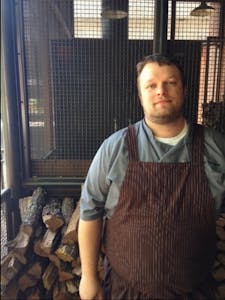 Owner/Pitmaster/Chef: The Granary; Opened 2012
Owner/Pitmaster/Chef: The Granary; Opened 2012
Age: 31
Smoker: Wood-Fired Rotisserie Smoker
Wood: Live Oak
There isn’t another barbecue joint in Texas with as many menus to deal with as The Granary. They have a lunch menu with traditional barbecue items and a rotating daily lunch special that includes Cajun pulled pork and brisket pastrami. Their dinner menu is a completely different collection of composed dishes that changes monthly. Then there are the special dinners. Just this month chef Tim Rattray will create specific tasting menus for a Ranger Creek beer dinner and a collaborative dinner with Chef Scott Anderson. Needless to say, Tim Rattray is a busy man.
Tim and his brewmaster brother, Alex, opened The Granary in 2012 as a place for San Antonio to enjoy good beer and good barbecue. It’s also one of a growing number of Texas restaurants who take the pairing of beer and food seriously, so you can order a brown ale to go alongside your barbecue butter with confidence.
Daniel Vaughn: What is your background in cooking?
Tim Rattray: I came from a family that loved good food. Our road trips as a kid were planned around good restaurants.
DV: Did you go to culinary school?
TR: I did not. I went to Texas A&M and got a science degree. Then I ended up changing careers shortly after. My first professional cooking job was at Biga on the Banks with Bruce Auden. I worked my way up to the dinner service line.
DV: Did you complete your degree at A&M?
TR: Yes. I have a Bachelor of Science from Texas A&M class of ’04.
DV: So you’re doing nothing with it?
TR: [Laughing] Actually I am. A lot of the food science interests me, so my chemistry and biology background helps when we’re talking about cell interaction and gluten formation. It all makes sense.
DV: It was all part of the grand plan, right?
TR: It worked out. When I first got into a kitchen it was like I’d wasted all of that education, but now I’m so glad I did. So much of cooking is about science.
DV: Did your parents feel the same way? Did they give you any pushback about the path you chose?
TR: My parents just wanted to see me do well. Other chefs around me spent four years in a hard core kitchen right after high school. That right there is an education.
DV: When you started working in a restaurant environment, did you feel like you were starting from behind since you’d “wasted” time in college?
TR: I did. I still do. I like to know that I’m prepared before I go for it. Once I got into kitchens I just started absorbing as much as I could. I started reading blogs and using Twitter to reach out to people. The Ideas in Food blog was a huge discovery. The internet has opened up the possibility of interacting with madly skilled chefs.
DV: Take me down the path from Biga on the Banks to The Granary.
TR: I was at Biga for about a year. Then I heard about a place in town called La Rêve run by Andrew Weissman. It was classic French fine dining. I didn’t go to cooking school, so I wanted to go somewhere to learn French techniques. I started there wiping plates and chopping vegetables, then ended up cooking right next to him. La Rêve in French means “the dream.”
DV: Aha! No wonder you were drawn to it.
TR: It was an insanely tight kitchen. That was one of the most beneficial things I could have done from an experience standpoint. Andrew Weissman has had a big impact on my life. From La Rêve, I helped him open Il Sogno and The Sandbar. In between I took some time to go cook in a few kitchens in New York. One was Le Bernardin and another was Le Cirque.
DV: Weissman has also had a big impact on bringing attention to the San Antonio dining scene, right?
TR: Yes. He got a New York Times review. He was in the top 10 in Gourmet Magazine. That was the first time San Antonio got the national spotlight for something other than tacos.
DV: Now you’re providing something entirely different at The Granary. I’ve never eaten at a barbecue joint like yours that has a set menu for lunch and a completely different one for dinner. How did that idea form when you were coming up with the concept for the Granary?
TR: My brother and I were talking about this idea for barbecue and beer. He was home brewing and the beer. He was legitimately making awesome beer, so we were wondering how to put the two together. We’re in Texas, so beer and barbecue are the two major food groups, so what would happen if we made great craft beer in-house and then used meat that’s ethically and humanely raised? Then we would make everything in house like the sauce, the bread, and the pickles. From there I built a smoker with a friend. In the back yard I was smoking lamb legs and goat carcasses, and ducks, and pork bellies. The curiosity from the fine dining side of enhancing and manipulating flavors started to let me push the limits and be creative while paying respect to the tradition. All of that turned into our progressive, modernist style. People have called it all sorts of things, but for us it’s using smoke and live fire on a platform that’s unpretentious but thoughtful.
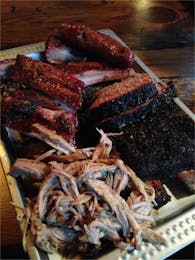
DV: Among those things that people have called it is “not barbecue.” What is your response to that?
TR: The people that hold those beliefs are real traditionalists. I understand because I also love traditional barbecue. For the time we’re open, traditional barbecue is more than half of what we do. I’m saying, why can’t we have those things and agree that they’re delicious while also trying something a little different? Some people might not agree, but that’s how my mind works. I’ll see an ingredient and think, how can I smoke that, or why can’t we have that flavor with a different texture?
DV: You mentioned that when you opened the idea was to do traditional barbecue. How did the concept evolve to also include the composed dishes that you serve at dinner?
TR: The initial sentence that started the whole thing was, “wouldn’t it be cool if you could go somewhere in San Antonio and get awesome barbecue and really good beer?” Then my brother and I didn’t talk about it for two months. Then my mind started racing about what else we could do. The idea evolved over time, especially what we do for dinner.
DV: That first sentence that you talked about, when did that conversation occur?
TR: It was about two years before we opened. My brother and I did a brew tour in Austin. We talked about it on the way back. I was still new to craft beer before that trip. My reference was the Miller Lite from college, and we were tasting English ales, lagers, and Belgian sours. It was a whole rainbow of flavors out there that I didn’t know were possible with beer.
DV: How did you get the deal done with the Pearl to open a restaurant there?
TR: We looked at the city as a whole to see where the food pulse was that would support this type of restaurant. We thought it was here, so I reached out to the Pearl. The CEO said they were looking for something like that. They didn’t really understand what we were doing for dinner, but they liked the idea of barbecue and bringing brewing back to the Pearl. Then we started the long process of opening.
DV: It was long. I followed the process for a while, but I started wondering if it would ever open. What was the long process like?
TR: There were some frustrating aspects of opening. The two big issues were the specific design requirements from the Pearl for their building, and the other thing was dealing with a building that was over a hundred years old and didn’t have functioning plumbing or air conditioning.
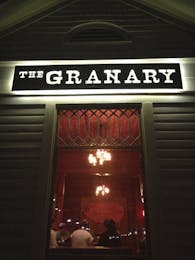
DV: Was it an old house?
TR: Yes. This was the house that the chief cooper for Pearl Brewery built in 1905, or 1908. The public records aren’t clear. The house was in the same family for three generations. We got in touch with the family and got a four page story about the house. They’ve since been in to eat, and it was really cool to connect with the family.
DV: Once you opened it didn’t take long to get national exposure. Was the Wall Street Journal the first article to come out?
TR: When the Esquire article hit, it was big.
DV: And you’d been open for how long?
TR: For six or eight months.
DV: That’s a nice bump after just a few months in business.
TR: At that point we were just trying to keep our heads above water. We thought we might build a good following in three or five years. The media exposure actually increased the amount of pressure. The plates we put together in the evening are all original creations, so when we start getting recognized then I know the guests will come in expecting more than they had the night before. I knew I had to work harder.
DV: How often do you change the dinner menu?
TR: We’ve been open seventeen months, and we’ve had twelve or thirteen different dinner menus. We don’t change the entire menu, like last week, we changed out three dishes. Out of eighteen items, there are only three things still on there from the original menu.
DV: If you’re looking for any advice from me, please never take the barbecue butter off the menu.
TR: The Texas toast is staying on there forever.
Texas Toast w/ Barbecue Butter
Capture drippings from smoking briskets and/or pork butts.
Cool drippings, skim off fat, and discard.
Whip 1 part drippings with 2 parts room temperature Plugra or Kerrygold butter.
Fry thick cut bread in melted beef tallow on low heat.
Season bread with salt and fresh cracked black pepper.
Serve with barbecue butter.
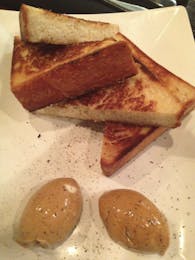
DV: In the ever-increasing trend of enjoying fat and barbecue, you have taken it to a different level.
TR: [Laughing] Yes. You’d be surprised how many briskets you need to smoke to get the drippings we need. The bread is sweet and tangy like what grandma would make.
DV: Did you ever eat anything like that dish growing up?
TR: When I was a kid my mom gave me a bread recipe that I was required to make for dinner. My mom was a scratch cook, so we grew up eating well, and I’ve always had a knack for baking.
DV: Where did you grow up?
TR: I spent nine years in England from the time I was three, so a lot of my food memories are from England and ethnic food like curries and Caribbean flavors. My dad grew up on the coast of Florida eating Cuban food.
DV: When did you get to Texas?
TR: We moved back to San Antonio after a short stop in Miami.
DV: What made you want to get into barbecue?
TR: We didn’t have a lot of money, but when it was my birthday we might get a steak or my dad would grill burgers. Grilling flavors were important to us when we were kids. When we came back from England to Texas, even Bill Miller was like a novelty for us. In college there was Rudy’s, and my wife’s family would always be cooking brisket and ribs. There was something about the perfume of smoke with meat that connected with me.
DV: In preparation for opening, did you travel the state eating other people’s barbecue?
TR: I did Luling, Lockhart, Austin, and Taylor. I really wanted to go the long established places.
DV: Were you nervous about the way Texas would embrace your more progressive menu?
TR: For me, it was about trying to be me instead of someone else. It wouldn’t make sense for me to try to be Aaron Franklin or Wayne Mueller. On a personal level I was comfortable with what we were doing, but was worried about what people would think. People had no frame of reference to have beef on a plate with fluffy cornbread that’s like angel food cake and pickled celery, and what the hell is coffee quinoa crunch? I love it, but when people come in they had to get over the fact that it wasn’t all traditional. Some tables got it, but others came in and just wanted a brisket sandwich, so they probably didn’t come back.

DV: I think in Texas there’s an expectation when your place is labeled a barbecue joint. I think Smoke in Dallas has had to deal with the same issue, but they’ve gotten through it.
TR: This winter we were smoke braising some pork shanks. Some people wouldn’t even try it because they couldn’t connect with the idea.
DV: That’s exactly why I enjoy coming in. I eat basically the same things over and over, so your place is refreshing to me, but I was wondering if the standard barbecue plate has always been on the dinner menu?
TR: Yes. We’ve always had the barbecue board on the dinner menu.
DV: It has to be tough in your position. You’ve had to go through the process of learning how to successfully do traditional barbecue, but you also have to constantly be creative with the dinner menu. It has to be hard to work on the traditional barbecue at the same time you’re trying to develop new menu items for the dinner menu.
TR: Yes. Cooking is tactile, so you can’t just use a thermometer. Every piece of meat is different. That’s what I talked about at the Austin Food & Wine Festival with Aaron Franklin. Consistency is the hardest part. There have been times when I had to throw briskets away and wanted to cry, but sometimes you just can’t serve it. We have a good group of guys in the kitchen that care, so everyone’s keeping an eye out.
DV: I’m guessing the barbecue side of things stays interesting for the science major in you.
TR: Yes. It’s an exercise in problem-solving, so from a creative side the challenge of making consistent product is a huge turn-on even if it’s frustrating.
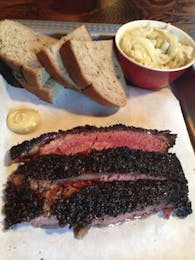
DV: You’ve said some customers don’t quite “get” the dinner menu, but what are the challenges of inviting a crowd more used to fine dining into a barbecue joint?
TR: Some people are used to a burger joint who can just form some more patties, but when our clod is gone it’s gonna be twelve hours before it’s done. We’ve definitely been hammered by both sides of the aisle.
DV: What are you working on next for the menu?
TR: Right now I’m breaking some lamb saddles down because we’re putting them on the menu with a charred avocado mousse. We’re dusting the lamb loin with chiles and grilling it.
DV: Are your grilled items over wood too?
TR: Yeah. We have a Big Green Egg on the line, and we use live oak for pretty much everything, even cold smoking.
DV: The menu changes every few weeks, so is there anything you’re developing for the near future?
TR: We have a local chicken farmer who is just coming back into season, so I’d love to do something with chicken and ramps or morels. I keep a notebook and write down ideas. They might just be snippets, but when I get an idea I go back through the notebook to look at my notes. We have a great farmers market here at the Pearl that we’re starting to tap into. We just started doing grilled artichokes. We serve them with soft-boiled eggs that are steeped in chai tea. Then we put tempura-fried artichoke leaves and spinach sauce on top. The whole idea came from spinach and artichoke dip that my wife loves, but we just went a completely different direction with it.
DV: Have you thought about going weird directions with the more traditional barbecue, or are you not ready for that public flogging?
TR: I’m looking at curing a brisket with Marmite and seeing what it does. For the lunch menu we run a different special every day.
DV: How do you keep up with it all?
TR: It can be a thankless industry. I see my staff more than I see my wife, but we’ve got a great group of people here now. There’s no way fifteen months in that I could be here for lunch and dinner, and loading the meat on, and baking bread in the morning. It worked for a couple of months at the start, but I wouldn’t be here right now if I had to keep doing all of it. We’ve got good people who work their tail off.







